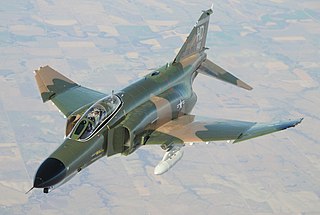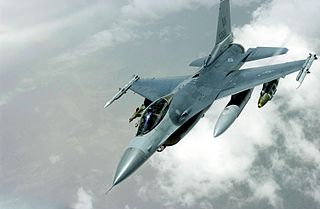Related Research Articles
The AIM-120 Advanced Medium-Range Air-to-Air Missile, is an American beyond-visual-range air-to-air missile capable of all-weather day-and-night operations. It uses active transmit-receive radar guidance instead of semi-active receive-only radar guidance. It is a fire-and-forget weapon, unlike the previous generation Sparrow missiles which needed guidance from the firing aircraft. When an AMRAAM missile is launched, NATO pilots use the brevity code "Fox Three".

The McDonnell Douglas F-15 Eagle is an American twin-engine, all-weather tactical fighter aircraft designed by McDonnell Douglas. Following reviews of proposals, the United States Air Force (USAF) selected McDonnell Douglas's design in 1969 to meet the service's need for a dedicated air superiority fighter. The Eagle first flew in July 1972, and entered service in 1976. It is among the most successful modern fighters, with over 100 victories and no losses in aerial combat, with the majority of the kills by the Israeli Air Force.

The McDonnell Douglas F-4 Phantom II is an American tandem two-seat, twin-engine, all-weather, long-range supersonic jet interceptor and fighter-bomber originally developed by McDonnell Aircraft for the United States Navy. Proving highly adaptable, it entered service with the Navy in 1961 before it was adopted by the United States Marine Corps and the United States Air Force, and by the mid-1960s it had become a major part of their air arms. Phantom production ran from 1958 to 1981 with a total of 5,195 aircraft built, making it the most produced American supersonic military aircraft in history, and cementing its position as a signature combat aircraft of the Cold War.

The Mikoyan-Gurevich MiG-17 is a high-subsonic fighter aircraft produced in the Soviet Union from 1952 and was operated by air forces internationally. The MiG-17 was license-built in China as the Shenyang J-5 and Poland as the PZL-Mielec Lim-6. The MiG-17 is still being used by the North Korean air force in the present day and has seen combat in the Middle East and Asia.

The Mikoyan-Gurevich MiG-15 is a jet fighter aircraft developed by Mikoyan-Gurevich for the Soviet Union. The MiG-15 was one of the first successful jet fighters to incorporate swept wings to achieve high transonic speeds. In aerial combat during the Korean War, it outclassed straight-winged jet day fighters, which were largely relegated to ground-attack roles. In response to the MiG-15's appearance and in order to counter it, the United States Air Force rushed the North American F-86 Sabre to Korea.

The Mikoyan MiG-29 is a twin-engine fighter aircraft designed in the Soviet Union. Developed by the Mikoyan design bureau as an air superiority fighter during the 1970s, the MiG-29, along with the larger Sukhoi Su-27, was developed to counter new U.S. fighters such as the McDonnell Douglas F-15 Eagle and the General Dynamics F-16 Fighting Falcon. The MiG-29 entered service with the Soviet Air Forces in 1983.

The Mikoyan-Gurevich MiG-25 is a supersonic interceptor and reconnaissance aircraft that is among the fastest military aircraft to enter service. Designed by the Soviet Union's Mikoyan-Gurevich bureau, it is an aircraft built primarily using stainless steel. It was to be the last plane designed by Mikhail Gurevich, before his retirement.

The Northrop/McDonnell Douglas YF-23 is an American single-seat, twin-engine stealth fighter aircraft technology demonstrator designed for the United States Air Force (USAF). The design was a finalist in the USAF's Advanced Tactical Fighter (ATF) competition, battling the Lockheed YF-22 for a production contract. Two YF-23 prototypes were built, nicknamed "Black Widow II" and "Gray Ghost".

Dissimilar air combat training (DACT) was introduced as a formal part of US air combat training after disappointing aerial combat exchange rates in the Vietnam War.

Colonel Charles Barbin DeBellevue is a retired officer in the United States Air Force (USAF). In 1972, DeBellevue became one of only five Americans to achieve flying ace status during the Vietnam War, and the first as a USAF weapon systems officer, an integral part of two-man aircrews with the emergence of air-to-air missiles as the primary weapons during aerial combat. He was credited with a total of six MiG kills, the most earned by any U.S. aviator during the Vietnam War, and is a recipient of the Air Force Cross.

The 555th Fighter Squadron is part of the 31st Operations Group at Aviano Air Base, Italy. It operates General Dynamics F-16 Fighting Falcon aircraft conducting multirole air and ground missions.
The Vietnam People's Air Force Museum, Hanoi or Bảo Tàng Phòng Không - Không Quân is located on Truong Chinh Street in the Bach Mai District of Hanoi. The museum is on the edge of the disused Bach Mai Airfield.
During the 1991 Gulf War and subsequent operations in no-fly zones over Iraq, Coalition air forces faced the Iraqi Air Force (IQAF), the fourth largest air force in the world at the time. In the opening days of the war, many air-to-air engagements occurred, between Iraqi interceptors and a variety of different Coalition aircraft.
Cesar Antonio Rodriguez is a former United States Air Force (USAF) officer and pilot who served from 1981 to 2006. With three air-to-air combat victories, he joined USAF pilots Thomas Dietz, Robert Hehemann and Robert Wright as the closest to becoming a flying ace of any U.S. pilot since the Vietnam War. Rodriguez scored his kills in an F-15 Eagle - the first two kills in 1991, during the first Gulf War, against a Mikoyan MiG-29 and a Mikoyan MiG-23 of the Iraqi Air Force, and his third kill came against a MiG-29 of the Yugoslav air force during the 1999 NATO bombing of Yugoslavia.
Operation Samurra was an operation by the Iraqi Air Force (IQAF) during the Gulf War to decisively engage McDonnell Douglas F-15C Eagle fighters from the United States Air Force (USAF) using Mikoyan-Gurevich MiG-25 interceptors, and break the "wall" of F-15s that the Coalition had established along Iraq's border with Iran. It demonstrated the last true offensive operation of the IQAF before grounding their air assets in an attempt to preserve them for future use. Through careful planning and coordination, two MiG-25 jets successfully caught two USAF F-15 fighters off guard and engaged them in a dogfight. After several minutes of aerial maneuvering and several fired missiles, the Iraqi jets returned to Tammuz Air Base undamaged, and the F-15s returned to Saudi Arabia, albeit with one damaged.

The 177th Fighter Aviation Regiment PVO was a fighter regiment of the Soviet Air Defense Forces during World War II and the Cold War, later becoming part of the Russian Air Defense Forces and finally the Russian Air Force.
References
- ↑ "US Navy and US Marine Corps BuNos Third Series (160007 to 163049)." joebaugher.com Retrieved: 19 December 2019.
- ↑ "US Navy and US Marine Corps BuNos Third Series (160007 to 163049)." joebaugher.com Retrieved: 19 December 2019.
- ↑ US Navy and US Marine Corps BuNos Third Series (156170 to 160006)." joebaugher.com Retrieved: 19 December 2019.
- ↑ US Navy and US Marine Corps BuNos Third Series (156170 to 160006)." joebaugher.com Retrieved: 19 December 2019.
- ↑ "1985 USAF Serial Numbers." joebaugher.com Retrieved: 20 December 2019.
- ↑ "1985 USAF Serial Numbers." joebaugher.com Retrieved: 20 December 2019.
- ↑ "1985 USAF Serial Numbers." joebaugher.com Retrieved: 20 December 2019.
- ↑ "1985 USAF Serial Numbers." joebaugher.com Retrieved: 20 December 2019.
- ↑ "1985 USAF Serial Numbers." joebaugher.com Retrieved: 20 December 2019.
- ↑ "1983 USAF Serial Numbers." joebaugher.com Retrieved: 20 December 2019.
- ↑ "US Navy and US Marine Corps BuNos Third Series (163050 to 164195)." joebaugher.com Retrieved: 19 December 2019.
- ↑ "US Navy and US Marine Corps BuNos Third Series (163050 to 164195)." joebaugher.com Retrieved: 19 December 2019.
- ↑ "1985 USAF Serial Numbers." joebaugher.com Retrieved: 20 December 2019.
- ↑ "1985 USAF Serial Numbers." joebaugher.com Retrieved: 20 December 2019.
- ↑ "1979 USAF Serial Numbers." joebaugher.com Retrieved: 20 December 2019.
- ↑ "1979 USAF Serial Numbers." joebaugher.com Retrieved: 20 December 2019.
- ↑ "1985 USAF Serial Numbers." joebaugher.com Retrieved: 20 December 2019.
- ↑ "1985 USAF Serial Numbers." joebaugher.com Retrieved: 20 December 2019.
- ↑ "1985 USAF Serial Numbers." joebaugher.com Retrieved: 20 December 2019.
- ↑ "1985 USAF Serial Numbers." joebaugher.com Retrieved: 20 December 2019.
- ↑ "1985 USAF Serial Numbers." joebaugher.com Retrieved: 20 December 2019.
- ↑ "1984 USAF Serial Numbers." joebaugher.com Retrieved: 20 December 2019.
- ↑ "1984 USAF Serial Numbers." joebaugher.com Retrieved: 20 December 2019.
- ↑ "1984 USAF Serial Numbers." joebaugher.com Retrieved: 20 December 2019.
- ↑ "1979 USAF Serial Numbers." joebaugher.com Retrieved: 20 December 2019.
- ↑ "1985 USAF Serial Numbers." joebaugher.com Retrieved: 20 December 2019.
- ↑ "1979 USAF Serial Numbers." joebaugher.com Retrieved: 20 December 2019.
- ↑ "1989 USAF Serial Numbers." joebaugher.com Retrieved: 19 December 2019.
- ↑ "1977 USAF Serial Numbers." joebaugher.com Retrieved: 19 December 2019.
- ↑ "US Navy and US Marine Corps BuNos Third Series (160007 to 163049)." joebaugher. Retrieved: 19 December 2019.
- ↑ "1984 USAF Serial Numbers." joebaugher.com Retrieved: 20 December 2019.
- ↑ "1979 USAF Serial Numbers." joebaugher.com Retrieved: 20 December 2019.
- ↑ "1985 USAF Serial Numbers." joebaugher.com Retrieved: 20 December 2019.
- ↑ "1980 USAF Serial Numbers." joebaugher.com Retrieved: 20 December 2019.
- ↑ "1985 USAF Serial Numbers." joebaugher.com Retrieved: 20 December 2019.
- ↑ "1979 USAF Serial Numbers." joebaugher.com Retrieved: 20 December 2019.
- ↑ "1980 USAF Serial Numbers." joebaugher.com Retrieved: 20 December 2019.
- ↑ "1981 USAF Serial Numbers." joebaugher.com Retrieved: 19 December 2019.
- ↑ "1984 USAF Serial Numbers." joebaugher.com Retrieved: 19 December 2019.
- ↑ "1984 USAF Serial Numbers." joebaugher.com Retrieved: 19 December 2019.
- ↑ "1984 USAF Serial Numbers." joebaugher.com Retrieved: 19 December 2019.
- ↑ "1990 USAF Serial Numbers." joebaugher.com Retrieved: 19 December 2019.
- ↑ "1986 USAF Serial Numbers." joebaugher.com Retrieved: 19 December 2019.
- ↑ "1989 USAF Serial Numbers." joebaugher.com Retrieved: 19 December 2019.
- ↑ "1989 USAF Serial Numbers." joebaugher.com Retrieved: 19 December 2019.
- ↑ "1986 USAF Serial Numbers." joebaugher.com Retrieved: 19 December 2019.
- ↑ "1986 USAF Serial Numbers." joebaugher.com Retrieved: 19 December 2019.
- ↑ "1986 USAF Serial Numbers." joebaugher.com Retrieved: 19 December 2019.
- ↑ "1991 USAF Serial Numbers." joebaugher.com Retrieved: 19 December 2019.
- ↑ "U.S. Navy F/A-18E Super Hornet That Shot Down Syrian Su-22 in 2017 Spotted with "New" Kill Markings at NAS Fallon". 29 October 2019.
- ↑ "The inside story of how a US Navy pilot shot down a Syrian jet." navytimes.com Retrieved: 19 December 2019.